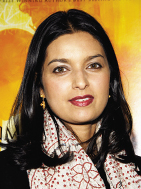Jhumpa Lahiri, Rice

Jhumpa Lahiri won the 2000 Pulitzer Prize for Fiction for her short story collection Interpreter of Maladies (1999). She also gained acclaim for her novel The Namesake (2003), which was adapted into a popular film. Her writing, often autobiographically inspired, explores issues of assimilation experienced by Indian immigrants in America. President Barack Obama recently appointed her to the President’s Committee on the Arts and Humanities. In the following article, first published on November 23, 2009, in the New Yorker, Lahiri focuses on the significance of the meal that her father prepared for special occasions.
AS YOU READ: Consider why this meal is so important to the author’s father.
1
My father, seventy-eight, is a methodical man. For thirty-nine years, he has had the same job, cataloguing books for a university library. He drinks two glasses of water first thing in the morning, walks for an hour every day, and devotes almost as much time, before bed, to flossing his teeth. “Winging it” is not a term that comes to mind in describing my father. When he’s driving to new places, he does not enjoy getting lost.
2
In the kitchen, too, he walks a deliberate line, counting out the raisins that go into his oatmeal (fifteen) and never boiling even a drop more water than required for tea. It is my father who knows how many cups of rice are necessary to feed four, or forty, or a hundred and forty people. He has a reputation for andaj — the Bengali° word for “estimate” — accurately gauging quantities that tend to baffle other cooks. An oracle° of rice, if you will.
3
But there is another rice that my father is more famous for. This is not the white rice, boiled like pasta and then drained in a colander, that most Bengalis eat for dinner. This other rice is pulao, a baked, buttery, sophisticated indulgence, Persian in origin, served at festive occasions. I have often watched him make it. It involves sautéing grains of basmati in butter, along with cinnamon sticks, cloves, bay leaves, and cardamom pods. In go halved cashews and raisins (unlike the oatmeal raisins, these must be golden, not black). Ginger, pulverized into a paste, is incorporated, along with salt and sugar, nutmeg and mace, saffron threads if they’re available, ground turmeric if not. A certain amount of water is added, and the rice simmers until most of the water evaporates. Then it is spread out in a baking tray. (My father prefers disposable aluminum ones, which he recycled long before recycling laws were passed.) More water is flicked on top with his fingers, in the ritual and cryptic manner of Catholic priests. Then the tray, covered with foil, goes into the oven, until the rice is cooked through and not a single grain sticks to another.
4
Despite having a superficial knowledge of the ingredients and the technique, I have no idea how to make my father’s pulao, nor would I ever dare attempt it. The recipe is his own, and has never been recorded. There has never been an unsuccessful batch, yet no batch is ever identical to any other. It is a dish that has become an extension of himself, that he has perfected, and to which he has earned the copyright. A dish that will die with him when he dies.
5
In 1968, when I was seven months old, my father made pulao for the first time. We lived in London, in Finsbury Park, where my parents shared the kitchen, up a steep set of stairs in the attic of the house, with another Bengali couple. The occasion was my annaprasan, a rite of passage in which Bengali children are given solid food for the first time; it is known colloquially as a bhath, which happens to be the Bengali word for “cooked rice.” In the oven of a stove no more than twenty inches wide, my father baked pulao for about thirty-five people. Since then, he has made pulao for the annaprasans of his friends’ children, for birthday parties and anniversaries, for bridal and baby showers, for wedding receptions, and for my sister’s Ph.D. party. For a few decades, after we moved to the United States, his pulao fed crowds of up to four hundred people, at events organized by Prabasi, a Bengali cultural institution in New England, and he found himself at institutional venues — schools and churches and community centers — working with industrial ovens and stoves. This has never unnerved him. He could probably rig up a system to make pulao out of a hot-dog cart, were someone to ask.
6
There are times when certain ingredients are missing, when he must use almonds instead of cashews, when the raisins in a friend’s cupboard are the wrong color. He makes it anyway, with exacting standards but a sanguine° hand.
7
When my son and daughter were infants, and we celebrated their annaprasans, we hired a caterer, but my father made the pulao, preparing it at home in Rhode Island and transporting it in the trunk of his car to Brooklyn. The occasion, both times, was held at the Society for Ethical Culture, in Park Slope. In 2002, for my son’s first taste of rice, my father warmed the trays on the premises, in the giant oven in the basement. But by 2005, when it was my daughter’s turn, the representative on duty would not permit my father to use the oven, telling him that he was not a licensed cook. My father transferred the pulao from his aluminum trays into glass baking dishes, and microwaved, batch by batch, rice that fed almost a hundred people. When I asked my father to describe that experience, he expressed no frustration. “It was fine,” he said. “It was a big microwave.”
Questions to Start You Thinking
Question
0TFTqHibhgEbHkBa8Hbbof8nw91PjLV6CGRXfBo8g92ZdBKivvpRxfS5bEfCt1/Nk8uh9fkZDm0/zL9iY/phLGHSOvCf3qln2ghyORJ5eWDqTI3hVGq7Ngp+pBMQ1r/kZiZdDzBPSuVccnHkplZtnRjcFAG6gr3q+uNl6M41cdhbybaSCMwPeouZhtxbFqIc3BfiXkQPb+klqAksyPieSiEHOb8xXBLQQ+iJyRKnsBoaW8hLFSv6rrkDYZ9oKnEZiGGo9OGhU9QFtwPUtkzH4JImwzm1BnR8kshePkFTDPoLmbdhQuestion
DgHqoBLvXGm6800iwjBq8W6v4AyotR+g8Zl7B/iik51KM0BU7xftCqcUvL8mSPeC0aCcV50tMGEnE55n9rfxo2rb/XsM98s5woOVdDOYhMSMt85fPfcAfAZbFx3iwky39MqapA7AsIhX3zf3ih1DqQIIhPzuZUAswwcmOFu4iYcYlj2AZTBFwB1ookJV+LG+RxRYTeBMAu7ws3jJt2EhVSwUWH3Niw0+F+3uh5nFwUOAAviL8hw/0S+LX9TgrnaKKYI/FETghHcIYfgEMl6z7uMksZlsBjLW5Gci78p0sXEtVIaPd4GSBp6dgYWYHCqb5gehsjvnc7Rk2WQBk/BD8RA2/Z/ckBPZRGlDxAKhZlrwSJOPQuestion
Qo7vPuW3M+V5Lqb2JgcxQi/5Ug0FgXFynRNkhPiDpAyTZZUm2LPfOvA4B+eD4Jdk/NtGDU9P3FmXotwNr6jdFYjIpKUAQl09GhqUxaTyBKssy1RYNsAM5k2/i4CuFkcqfIanQKjNQCtBz6kqgknFRyyurHZJ34pZuyXRmNT1VklKumjUtYYdBhffDeWE1lD7bH2WUZfNOCsUTSRXjs8u/FpzqSqm95fFeOyXGUV2eMhgZMaf/CQ2yxZFprgqvPA7fyKvvRuzzF+fdbxgX47k+mdZ4z/p12kaQuestion
LufOUL40oQiautPn0dOD1u75UAZ4ljLNqLy56FhHRc9eG7RBeZBwiU0E2mlDIwpK53b2J1lAedLFV33RuNy8+IohqK6w41F09F2wlxdmoo4W1f3NFMFH1fsmo6T2zZYUcIhmaTqPMjx+YXr9QRtEmVeYBR+EJXhm0va+5ojoTqUyoE/di7vANlKCPPA9WK4It17nT8Jmb9tTc4RwDH2M/EQfX291ss4Jl47080tJifiuKC6s5MyKvAAzyX49/FmOfSHvgpvWIGqknUDgHUAyk/X6u67ngzSYlLL51DO2l5q6fbL6NTSMX017tYHly3VowgKxbdRPloxHiMV+NiDd624L1oJSwyZQCWjHpn+yrFM=Question
XtNY3hM/3NCWBnOJxf3tL5D9awpZ03mJx2zF7UDsCYR4aSMpJdHywqml6XPkE7wrlm3u+ZPnbrSuvl0rVzMpYUMq+wYhzhRui6Yca/xe8SkKV0IkuPzDYcY2SSe8gmlJJBsJBZbBxTZ9Hd+ibWv0Ui7WbjD2KlqeLP/cGcY8pgl23H0y1RqWfKEXJ3raZPYyulx98NHSpPpgfy1yncHJqHAenzXWuJPrmnufgzEGOUs0CZRMzo4Y085MLbAAqVwtmGEv1ZcXVZ1sNfIHLlocTeNUYgMbf919nezbWG3wkmkbfsZtt1kK3WFaZAg2K4VQvKcFts7yzWzPsUbxiYBXzy/BxqVCamuocbfPaTxbgSUoqAIW1SmxNvRNN8h/K+jQ+zwZ5OHWKZCuQdEpbCkWBy325GCD80HtEhg/pOujdGBUQYlEEr00h73xfneK17uVktDm6Z504NxE/ynFziPsOg4YztM=
Journal Prompts
Question
ErFMBzA+ro2+iS4MZMtkPauISzW8HFvQA7W7j9VOt3S9I27bKE0Un5wQXM+IxJRtYNQYRsaoUJE65qsdPOrLnYqGXXA3tALemnIC4P4kr4mDrcixj3RDfrds9MphHe8L4Y7gag1S3y1RybgF1XZQjRhCrGg89aSPUq8gDV1SnKXMCiYVRGJfIbwq+dczYD5RRknV9s6NiX74eki1IwEajZ9WsARAdoO3eFuudxud/oVB65HSOqeINwqWYyKWGYWgya4EYXLJbKZjsqRLa7NxwSLNtGY=Question
A9xY1OTlJZQLR1KB7XgpEn35S0HisXqXekWOPHkwSkVCOSRep1zfCUzOrod8hpQokV1CgLRa8T+mnXSXlCguZXXErzmnT1BHPCgHpgheT7mxWIB1WLR/wjVHKQZ0rjQ2XWrc+4hcwyISbuofPYZsUknxZFea4JlRn+HjMBAfSoMV9teeWH3VCy/A73I3pTzynuPMBMdn1h7IxFYKNoSW1FnytgMDmF9nThgsYjjyK8zEWxQlTTpc3Mi5yLVRHg1tmYBe1E6GHP7NZ1xCxbwnGw==
Suggestions for Writing
Question
4xnseTmxYsUQ7EZG2WbDh4HgdOs+tGp2hAY+5OP1hV2/2py0Kz+Oyhm6gBHJHW6IWjNAYLEgvtV9U7SF9Ia5xhwpbjn3RUz1GeEpGjq3szFZO5laDU3XHaeK+/r25fuErdggNaY+vH7nUlYk7ChK2I13P/b/hjhd0eYvpFo1IUEFABOc1svhSTUbtGJoNcJk2LTlLjTQhO8GElX5BhyKAp6zBHyvdyl7SgjcBVusACFxXacZb4LUl/W+6L+rjbZvXTitS+RLDlqgf0uobVpT0wKl1rSnHG+gWHVhTgs94PwUEmguddO66m9/cvTK8undx/BSrfq4buyBgkSxU58o42dw2m9RSRPf6GI77xYZfPg=Question
WO2RNJ5/jaEPWAIkAJgGFcDuL5VG9tbahUG6JzVfCRCiIV4XLayf9ElNJJtzxyagI8oVoTDkPsohKvnFa4m4Z6j4I9Y75ett+/OP4fwFwrY3PNpwxTvwHUR85IPe5/5ketwFYsHoxxbljyTjoZKrwqc958zai9tpzNP8vm/dspbwTx3+WJ7X1wIwt7KzccztXj77u3608GxYLgOfkbVFq5tl4YbhR9WVYMbGsKrO4o6emo+0oNoh2qCxQDB34NpOTDByQ0JTIjoqe1/N6+WVT6HYWTsoAyOOIDZISyMyTJiVk5tqyzME2F6FHq6HoudEJjFC0aZO06aNACtM4pBIjvKekixyGLGSw1xx6s7uU4wfiQ/K6zUDzfxPvaImTbRzOrpRjIlYQF6uo+liV5MK7Bqz2GkYVAyRn6YPHAszKgiANiX8CSTnLgbsfIDaDiE7zdtQcV/OEBHVoTTN0SCxep1/gVHdE9FYUN/cWw==